I post type personalizzati consentono di andare oltre i post e le pagine standard. Permettono di creare tipi di contenuto diversi, adatti alle esigenze specifiche del sito.
Ad esempio, i post type personalizzati consentono di trasformare il sito WordPress da una semplice piattaforma di blog in un robusto sistema di gestione dei contenuti(CMS).
Ecco perché utilizziamo alcuni post type / tipi di contenuto personalizzati nei nostri siti web. In questa guida vi mostreremo come creare facilmente dei post type / tipi di contenuto personalizzati in WordPress.

Che cos’è un tipo di contenuto personalizzato in WordPress?
Sul vostro sito web WordPress, i post type sono utilizzati per distinguere i diversi tipi di contenuto in WordPress. I post e le pagine sono entrambi post type / tipi di contenuto, ma hanno scopi diversi.
Di default, WordPress è dotato di alcuni tipi di contenuto:
- Pubblica
- Pagina
- Allegato
- Revisione
- Menu Nav
Detto questo, è possibile creare dei post type personalizzati, noti come custom post type. Questi sono utili per creare contenuti con un formato diverso da quello di una pagina o di un post standard.
Supponiamo che si gestisca un sito web di recensioni di film. Allora probabilmente vorrete creare un post type “recensioni di film”. Si possono anche creare post type personalizzati per portafogli, testimonianze, prodotti e altro ancora.
Inoltre, i post type / tipo di contenuto possono avere diversi campi personalizzati e una propria struttura di categorie personalizzate.
Su WPBeginner, ad esempio, utilizziamo post type / tipo di contenuto personalizzato per le sezioni Offerte e Glossario, per tenerle separate dagli articoli del blog. Questo ci aiuta a organizzare meglio i contenuti del sito web.
Molti plugin WordPress popolari utilizzano post type / tipo di contenuto personalizzato per memorizzare i dati sul vostro sito web WordPress. Di seguito sono elencati alcuni plugin in alto che utilizzano i post type / tipo di contenuto:
- WooCommerce aggiunge un post type “prodotto” al vostro negozio online.
- WPForms crea un post type ‘wpforms’ per memorizzare tutti i moduli.
- MemberPress aggiunge un post type personalizzato “memberpressproduct”.
Video tutorial
Se preferite le istruzioni scritte, continuate a leggere.
È necessario creare dei post type personalizzati?
Prima di iniziare a creare post type personalizzati sul vostro sito WordPress, importa valutare le vostre esigenze. Spesso è possibile ottenere gli stessi risultati con una normale pagina o post.
Se non siete sicuri che il vostro sito abbia bisogno di tipi di post personalizzati, consultate la nostra guida su quando è necessario un tipo di post o una tassonomia personalizzata in WordPress.
Tenendo conto di ciò, vediamo come creare facilmente post type / tipo di contenuto personalizzati in WordPress per il vostro uso personale. Vi mostreremo due metodi e metteremo in copertina anche alcuni modi per visualizzare i post type personalizzati sul vostro sito web WordPress:
Pronti? Iniziamo.
Creare manualmente un tipo di post personalizzato utilizzando WPCode
La creazione di un post type personalizzato richiede l’aggiunta di codice al file functions.php del tema. Tuttavia, non raccomandiamo questa operazione a nessuno, se non agli utenti esperti, perché anche un piccolo errore può danneggiare il sito. Inoltre, se si aggiorna il tema, il codice viene cancellato.
Utilizzeremo invece WPCode, il modo più semplice e sicuro per chiunque di aggiungere codice personalizzato al proprio sito web WordPress.
Con WPCode è possibile aggiungere snippet personalizzati e attivare molte caratteristiche dalla libreria di codice integrata e preconfigurata. In altre parole, può sostituire molti plugin dedicati o monouso che avete installato.
Per prima cosa, è necessario installare e attivare il plugin gratuito WPCode. Per istruzioni dettagliate, consultate la nostra guida passo-passo su come installare un plugin di WordPress.
Una volta attivato, dalla vostra Bacheca di WordPress navigate su Code Snippets “ Aggiungi snippet. Passare il mouse su “Aggiungi codice personalizzato (nuovo snippet)” e fare clic su “Usa snippet”.
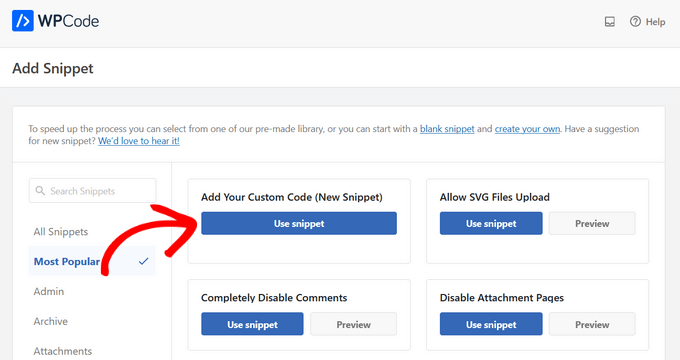
Si aprirà la schermata “Crea snippet personalizzato”.
Ora è possibile creare il titolo dello snippet di codice e attivare l’interruttore su “Attivo”.
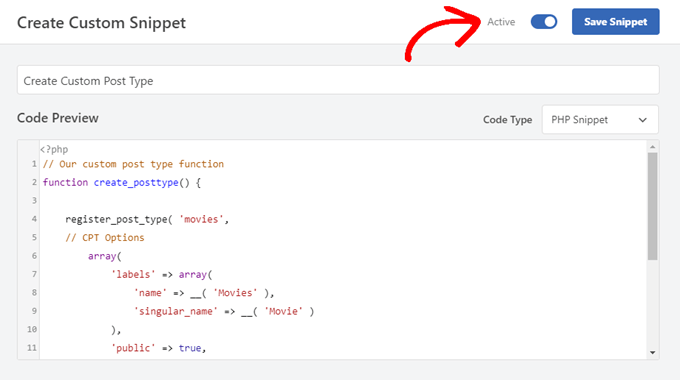
Dopodiché, è sufficiente incollare il seguente codice nell’area “Anteprima codice”. Questo codice crea un post type personalizzato di base chiamato “Film”, che apparirà nella barra laterale dell’amministratore e funzionerà con qualsiasi tema.
1 2 3 4 5 6 7 8 9 10 11 12 13 14 15 16 17 18 19 20 | // Our custom post type functionfunction create_posttype() { register_post_type( 'movies', // CPT Options array( 'labels' => array( 'name' => __( 'Movies' ), 'singular_name' => __( 'Movie' ) ), 'public' => true, 'has_archive' => true, 'rewrite' => array('slug' => 'movies'), 'show_in_rest' => true, ) );}// Hooking up our function to theme setupadd_action( 'init', 'create_posttype' ); |
Se si desidera solo un tipo di post personalizzato di base, è sufficiente sostituire film e Film con lo slug e il nome del proprio CPT e fare clic sul pulsante ‘Aggiorna’.
Tuttavia, se si desidera avere ancora più opzioni per il post type personalizzato, si dovrebbe usare il seguente codice invece di quello sopra riportato.
Il codice sottostante aggiunge molte altre opzioni al post type personalizzato “Film”, come il supporto per le revisioni, le immagini in evidenza e i campi personalizzati, oltre ad associare il post type personalizzato a una tassonomia personalizzata chiamata “generi”.
Nota: non combinate questi due snippet, altrimenti WordPress vi darà un errore perché entrambi gli snippet registrano lo stesso post type personalizzato. Si consiglia di creare un nuovo snippet con WPCode per ogni altro post type che si desidera registrare.
1 2 3 4 5 6 7 8 9 10 11 12 13 14 15 16 17 18 19 20 21 22 23 24 25 26 27 28 29 30 31 32 33 34 35 36 37 38 39 40 41 42 43 44 45 46 47 48 49 50 51 52 53 54 55 56 57 58 59 60 61 62 63 64 | /** Creating a function to create our CPT*/ function custom_post_type() { // Set UI labels for Custom Post Type $labels = array( 'name' => _x( 'Movies', 'Post Type General Name', 'twentytwentyone' ), 'singular_name' => _x( 'Movie', 'Post Type Singular Name', 'twentytwentyone' ), 'menu_name' => __( 'Movies', 'twentytwentyone' ), 'parent_item_colon' => __( 'Parent Movie', 'twentytwentyone' ), 'all_items' => __( 'All Movies', 'twentytwentyone' ), 'view_item' => __( 'View Movie', 'twentytwentyone' ), 'add_new_item' => __( 'Add New Movie', 'twentytwentyone' ), 'add_new' => __( 'Add New', 'twentytwentyone' ), 'edit_item' => __( 'Edit Movie', 'twentytwentyone' ), 'update_item' => __( 'Update Movie', 'twentytwentyone' ), 'search_items' => __( 'Search Movie', 'twentytwentyone' ), 'not_found' => __( 'Not Found', 'twentytwentyone' ), 'not_found_in_trash' => __( 'Not found in Trash', 'twentytwentyone' ), ); // Set other options for Custom Post Type $args = array( 'label' => __( 'movies', 'twentytwentyone' ), 'description' => __( 'Movie news and reviews', 'twentytwentyone' ), 'labels' => $labels, // Features this CPT supports in Post Editor 'supports' => array( 'title', 'editor', 'excerpt', 'author', 'thumbnail', 'comments', 'revisions', 'custom-fields', ), // You can associate this CPT with a taxonomy or custom taxonomy. 'taxonomies' => array( 'genres' ), /* A hierarchical CPT is like Pages and can have * Parent and child items. A non-hierarchical CPT * is like Posts. */ 'hierarchical' => false, 'public' => true, 'show_ui' => true, 'show_in_menu' => true, 'show_in_nav_menus' => true, 'show_in_admin_bar' => true, 'menu_position' => 5, 'can_export' => true, 'has_archive' => true, 'exclude_from_search' => false, 'publicly_queryable' => true, 'capability_type' => 'post', 'show_in_rest' => true, ); // Registering your Custom Post Type register_post_type( 'movies', $args ); } /* Hook into the 'init' action so that the function* Containing our post type registration is not * unnecessarily executed. */ add_action( 'init', 'custom_post_type', 0 ); |
Si può notare la parte in cui abbiamo impostato il valore gerarchico su false. Se si desidera che il tipo di post personalizzato si comporti come una pagina piuttosto che come un post, si può impostare questo valore a true.
Un’altra cosa da notare è l’uso ripetuto della stringa twentytwentyone , chiamata “dominio di testo”. Se il tema è pronto per la traduzione e si desidera che i post type / tipi di contenuto personalizzati siano tradotti, è necessario indicare il dominio di testo utilizzato dal tema.
È possibile trovare il dominio di testo del tema all’interno del file style.css nella cartella del tema o andando su Aspetto “ Editor file del tema nel pannello di amministrazione. Il dominio di testo sarà indicato nell’intestazione del file.
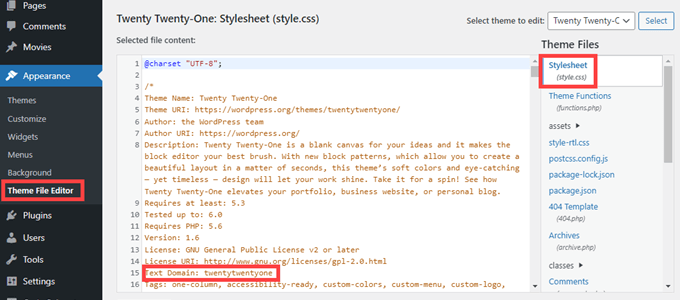
È sufficiente sostituire twentytwentyone con il dominio “Text Domain” del proprio tema.
Una volta soddisfatti delle modifiche, è sufficiente fare clic sul pulsante “Aggiorna” e WPCode si occuperà del resto.
Creare un tipo di post personalizzato con un plugin
Un altro modo semplice per creare un tipo di post personalizzato in WordPress è utilizzare un plugin. Questo metodo è consigliato ai principianti perché è sicuro e facilissimo.
La prima cosa da fare è installare e attivare il plugin Custom Post Type UI. Per maggiori dettagli, consultate la nostra guida passo passo su come installare un plugin di WordPress.
Dopo l’attivazione, è necessario andare su CPT UI ” Aggiungi / Modifica tipi di post per creare un nuovo tipo di post personalizzato. Dovreste trovarvi nella scheda “Aggiungi un nuovo tipo di post”.
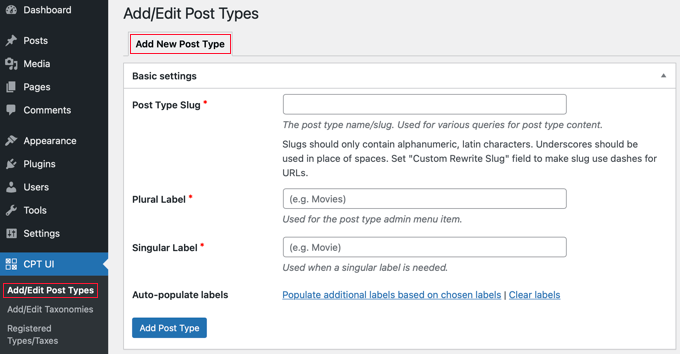
In quest’area è necessario fornire uno slug per il post type personalizzato, ad esempio “film”. Questo slug sarà utilizzato nell’URL e nelle query di WordPress, quindi può contenere solo lettere e numeri.
Sotto il campo slug, occorre fornire i nomi plurali e singolari del post type personalizzato.
Se lo si desidera, è possibile fare clic sul link “Popola etichette aggiuntive in base alle etichette scelte”. Questo riempirà automaticamente i campi delle etichette aggiuntive giù in basso e di solito salva il tempo.
Ora si può scendere fino alla sezione “Etichette aggiuntive”. Se non avete cliccato sul link che vi abbiamo indicato, dovrete fornire una descrizione per il vostro post type e cambiare le etichette.
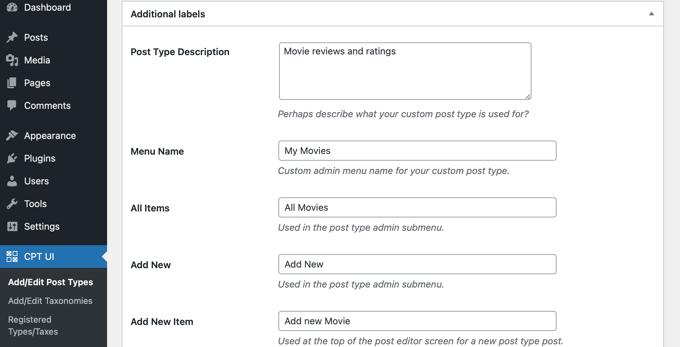
Queste etichette saranno utilizzate in tutta l’interfaccia utente di WordPress quando si gestisce il contenuto di quel particolare tipo di post.
Segue l’impostazione del post type. Da qui è possibile impostare diversi attributi per il tipo di post. Ogni opzione è accompagnata da una breve descrizione che ne spiega l’utilità.
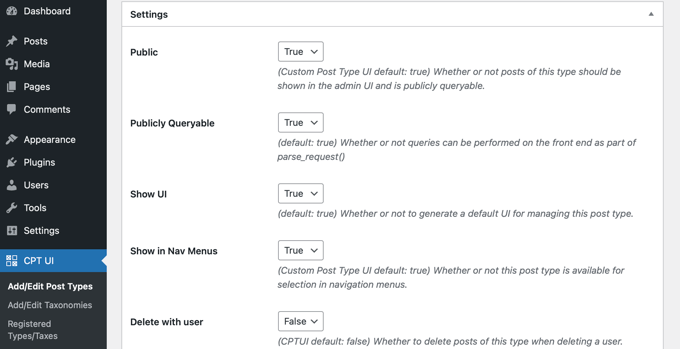
Ad esempio, si può scegliere di non rendere un tipo di post gerarchico come le pagine o di ordinare i post cronologici al contrario.
Sotto le impostazioni generali, si trova l’opzione per selezionare le funzioni di modifica supportate da questo tipo di post. È sufficiente selezionare le opzioni che si desidera includere.
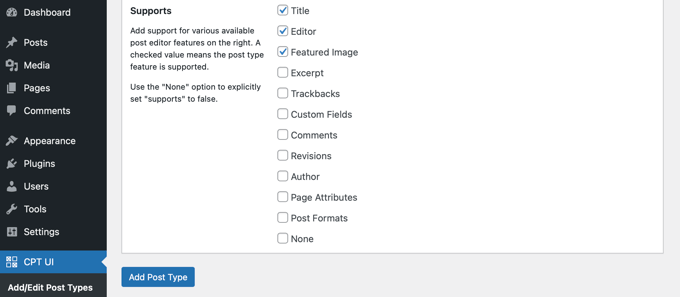
Infine, fare clic sul pulsante “Aggiungi tipo di post” per salvare e creare il tipo di post personalizzato.
È tutto, avete creato con successo il vostro post type personalizzato! Ora si può iniziare ad aggiungere contenuti.
Visualizzazione dei tipi di post personalizzati sul sito
WordPress è dotato di un supporto integrato per la visualizzazione dei post type / tipi di contenuto personalizzati. Una volta aggiunti alcuni elementi al nuovo post type personalizzato, è il momento di visualizzarli sul sito web.
I metodi che si possono utilizzare sono diversi e ognuno ha i suoi vantaggi.
Visualizzare i tipi di post personalizzati usando il modello di archivio predefinito
Innanzitutto, è sufficiente andare in Aspetto ” Menu e aggiungere un link personalizzato al menu. Questo link personalizzato è il collegamento al tipo di post personalizzato.
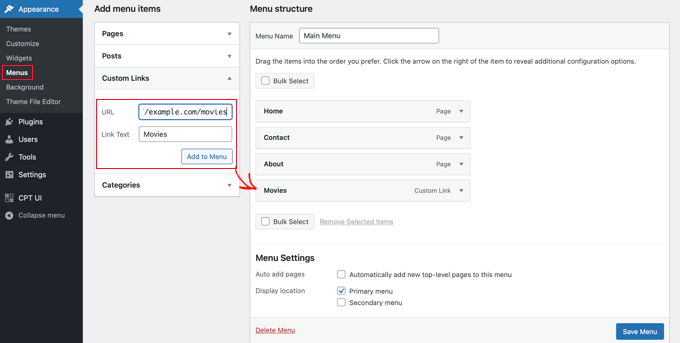
Se si utilizzano permalink SEO-friendly, l’URL del tipo di post personalizzato sarà probabilmente qualcosa di simile:
http://example.com/movies |
Se non si utilizzano permalink SEO-friendly, l’URL del tipo di post personalizzato sarà qualcosa di simile:
http://example.com/?post_type=movies |
Non dimenticate di sostituire “example.com” con il vostro nome di dominio e “movies” con il nome del vostro tipo di post personalizzato.
Si può quindi salvare il menu e visitare il frontend del sito web. Si vedrà la nuova voce di menu aggiunta e, facendo clic su di essa, si visualizzerà la pagina di archivio del post type personalizzato, utilizzando il template file archive.php del tema.

Creare modelli di tipi di post personalizzati
Se non vi piace l’aspetto della pagina di archivio per il vostro tipo di post personalizzato, potete utilizzare un modello dedicato per gli archivi dei tipi di post personalizzati.
È sufficiente creare un nuovo file nella cartella del tema e chiamarlo archive-movies.php. Assicuratevi di sostituire ‘movies’ con il nome del vostro tipo di post personalizzato.
Per iniziare, si può copiare il contenuto del file archive.php del proprio tema nel modello archive-movies.php e modificarlo in base alle proprie esigenze.
Ora, ogni volta che si accede alla pagina di archivio del post type personalizzato, questo template verrà utilizzato per visualizzarla.
Allo stesso modo, è possibile creare un template personalizzato per la visualizzazione a voce singola del proprio post type. Per farlo, è necessario creare single-movies.php nella directory del tema. Non dimenticate di sostituire ‘movies’ con il nome del vostro post type personalizzato.
Si può iniziare copiando il contenuto del template single.php del tema nel template single-movies.php e modificandolo in base alle proprie esigenze.
Per saperne di più, consultate la nostra guida su come creare modelli di post singoli personalizzati in WordPress.
Visualizzazione dei tipi di post personalizzati in prima pagina
Un vantaggio dell’uso dei tipi di post personalizzati è che questi mantengono separati i tipi di contenuto personalizzati dai normali post. Tuttavia, se lo si desidera, è possibile visualizzare i post type personalizzati sulla home page del sito web.
È sufficiente aggiungere questo codice come nuovo snippet utilizzando il plugin gratuito WPCode. Per istruzioni dettagliate, consultare la sezione di questo articolo dedicata all’aggiunta manuale del codice.
1 2 3 4 5 6 7 | add_action( 'pre_get_posts', 'add_my_post_types_to_query' ); function add_my_post_types_to_query( $query ) { if ( is_home() && $query->is_main_query() ) $query->set( 'post_type', array( 'post', 'movies' ) ); return $query;} |
Non dimenticate di sostituire ‘movies’ con il vostro tipo di post personalizzato.
Interrogare i tipi di post personalizzati
Se si ha familiarità con la codifica e si desidera eseguire query ad anello nei propri template, ecco come fare. Interrogando la base dati, è possibile recuperare elementi da un tipo di post personalizzato.
È necessario copiare il seguente frammento di codice nel modello in cui si desidera visualizzare il tipo di post personalizzato.
1 2 3 4 5 6 7 8 9 10 11 12 13 14 15 | <?php $args = array( 'post_type' => 'movies', 'posts_per_page' => 10 );$the_query = new WP_Query( $args ); ?><?php if ( $the_query->have_posts() ) : ?><?php while ( $the_query->have_posts() ) : $the_query->the_post(); ?><h2><?php the_title(); ?></h2><div class="entry-content"><?php the_content(); ?> </div><?php endwhile;wp_reset_postdata(); ?><?php else: ?><p><?php _e( 'Sorry, no posts matched your criteria.' ); ?></p><?php endif; ?> |
Questo codice definisce il tipo di post e il numero di post per pagina negli argomenti della nostra nuova classe WP_Query. Quindi esegue la query, recupera i post e li visualizza all’interno del ciclo.
Visualizzazione dei tipi di post personalizzati nei widget
Si noterà che WordPress ha un widget predefinito per visualizzare i post recenti, ma non consente di scegliere un post type personalizzato.
E se si volesse visualizzare in un widget le ultime voci del post type appena creato? Fortunatamente, esiste un modo semplice per farlo.
La prima cosa da fare è installare e attivare il plugin Custom Post Type Widgets. Per maggiori dettagli, consultate la nostra guida passo passo su come installare un plugin di WordPress.
Dopo l’attivazione, è sufficiente andare su Aspetto ” Widget e trascinare il widget ‘Post recenti (Custom Post Type)’ in una barra laterale.
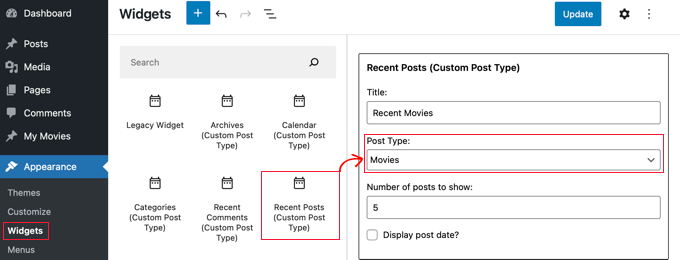
Questo widget consente di mostrare i post recenti di qualsiasi tipo di post. È necessario selezionare il tipo di post personalizzato dal menu a tendina ‘Post Type’ e selezionare le opzioni desiderate.
Dopodiché, fate clic sul pulsante “Aggiorna” nella parte superiore dello schermo e visitate il vostro sito web per vedere il widget in azione.

Il plugin fornisce anche widget di tipo post personalizzati che visualizzano archivi, un calendario, categorie, commenti recenti, ricerca e una nuvola di tag.
Quindi, sentitevi liberi di esplorare e scegliere quello di cui avete bisogno.
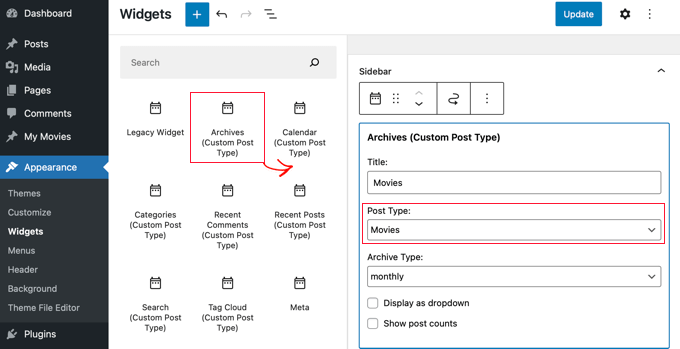
Speriamo che questo tutorial vi abbia aiutato a imparare come creare post type / tipo di contenuto personalizzati in WordPress. Potreste anche voler imparare a creare una pagina di archivio personalizzata in WordPress o dare un’occhiata al nostro elenco di pagine importanti che ogni blog WordPress dovrebbe avere.
Se questo articolo vi è piaciuto, iscrivetevi al nostro canale YouTube per le esercitazioni video su WordPress. Potete trovarci anche su Twitter e Facebook.





Anna
Good stuff! TY!
Is it possible to select a category for the CPT or create it’s own category list?
In your example of ‘Movies’ – select which category – Family, Drama, Action, etc?
WPBeginner Support
You can place the custom post types in a category, we have our article below that goes more in-depth on how to set that up
https://www.wpbeginner.com/wp-tutorials/how-to-add-categories-to-a-custom-post-type-in-wordpress/
Admin
Michelle
Hi! How can I set the query to only display custom post types by category on the category page? Currently, my query pulls ALL the post type, and I can’t seem to get just current category to display. thanks
WPBeginner Support
For customizing your search results, we would recommend taking a look at our guide below!
https://www.wpbeginner.com/wp-tutorials/how-to-create-advanced-search-form-in-wordpress-for-custom-post-types/
Admin
hussain
I have used this method which you explained above, but after creating a new menu, menu has created successfully created but when I click my menu it shows me error that “This page could not foun”
WPBeginner Support
It sounds like you would need to check and resave your permalinks to be safe. The other thing you could do would be to ensure you have a custom post type published for be found on the page.
Admin
Jarkko
So I used Code Snippets and the longer code but the features after ‘supports’ are not visible anywhere? Shouldn’t they be visible when clicking “Add new”… How do I insert a new movie and the information of it… I don’t get it.
WPBeginner Support
There should be a new section in your admin area where you can add new posts of your custom post type similar to how you add posts or pages.
Admin
Hafeez Ulllah
How cn display custom post type and where the code of display will be pasted
Johan
Seems to work perfectly, except for one thing: My theme is showing featured images on the pages. But when I use the CPT the images are never show, whatever I do. Any idea why?
WPBeginner Support
Your theme likely has a different template being used, if you reach out to your theme’s support they should be able to assist.
Admin
D Hebing
I tried many things with the code above, even compare it with the twintytwintyone theme of wordpress. But the post types don’t appear in the backend in the post editor.
WPBeginner Support
If none of the methods work for you, you would want to go through our troubleshooting steps below for finding the cause of the issue:
https://www.wpbeginner.com/beginners-guide/beginners-guide-to-troubleshooting-wordpress-errors-step-by-step/
Admin
Aurelien
5 years on, still useful! Thank you guys
WPBeginner Support
Glad you’ve found our content helpful
Admin
Max
Thanks very useful.
What do you think? In such cases from view of site speed it is better to install the plugin or write the code you provide?
WPBeginner Support
There shouldn’t be a difference in speed with either method being used.
Admin
Marshal Tudu
Thanks a lot for the help. I am trying to create a movie database on my website
Your post really helped me.
WPBeginner Support
Glad our guide was helpful
Admin
Harsha
How to migrate old posts to the new post type?
WPBeginner Support
You would want to use the plugin from our guide below:
https://www.wpbeginner.com/plugins/how-to-convert-post-types/
Admin
Leslie Campos
Great article! I tried to add two different post types on top of blog posts but the second add_action( ‘init’, ‘create_posttype’ ); overwrote the first one. I don’t know php but am wondering if it is possible to create two different ones in the same functions.php file. I don’t know php so perhaps it’s the way I am writing it?
WPBeginner Support
We would recommend using the plugin method to make the process easier. For a second post type with the code, you would need to copy from lines 4 to 17 and paste it on a new line below 17 then rename movies to a different name.
Admin
Girish Sahu
Really loved the article, Simple explained and was really of great help.
I wanted to mix custom posts and blogs post in a single page and was able to do so after reading the article.
WPBeginner Support
Glad our guide was helpful
Admin
Rafiozoo
Great recipe! Thank you!
One question:
‘exclude_from_search’ => true
should exclude my new custom posts from search results, I believe. Why does not work?
WPBeginner Support
It would depend on the search being used, you may want to take a look at our guide below:
https://www.wpbeginner.com/wp-tutorials/how-to-exclude-pages-from-wordpress-search-results/
Admin
snelson
Is there a way to display the new post type without the new slug? example. Default is mysite.com/newposttype/newpage
I would like
mysite.com/newpage/
WPBeginner Support
For customizing your permalinks, you would want to take a look at our article below:
https://www.wpbeginner.com/wp-tutorials/how-to-create-custom-permalinks-in-wordpress/
Admin
Yogesh
Hi,
I tried to use the manual approach using the simple code youve mentioned for creating a custom post type, but unfortunatley the posts dont show up (page not found error). The post permalink structure looks fine but the posts dont get displayed.
WPBeginner Support
You may want to clear the cache for your site and resave your permalinks to clear that issue.
Admin
rajni
hey thank you so much it working fine but i want to show post type on a page where only categories will show and when click on category post listed under this category will open can you please suggest me how to do that.thank you in advance
WPBeginner Support
For what it sounds like you’re wanting, you would want to ensure that categories are enabled for your custom post type and you could then add the category link in your menu for the page listing them how you want
Admin
G'will Chijioke
Hi, i am a newbie developer trying to create a custom post type.
All is good, just 1 huge problem.
I want to display the taxonomies that i created and linked to the post (tags and categories ) on the post itself.
i want to show it on my breadcrumbs as well.
pls it would mean d world if you helped me out.
Thanks in advance.
WPBeginner Support
Displaying the tags and categories would require you editing your theme’s template if your theme does not show that currently.
For breadcrumbs, if you’re using a plugin most should detect your taxonomy and give you options: https://www.wpbeginner.com/plugins/how-to-display-breadcrumb-navigation-links-in-wordpress/
Admin
rana ritesh singh
nice post
WPBeginner Support
Thank you
Admin
Haibatan
I want a CPT for my english posts, my site is in an RTL language, is it possible?
WPBeginner Support
You certainly could, you can also take a look at multilingual plugins such as the one in our article: https://www.wpbeginner.com/beginners-guide/how-to-easily-create-a-multilingual-wordpress-site/
Admin
RZKY
One question, in the default WP post dashboard, there’s a filter by categories feature on top of the list.
So I already link my custom post type with a custom taxonomy, but the filter menu is not showing (A portfolio post type, and the portfolio category custom taxonomy). Is there any settings i need to enable? I’m doing this from inside my functions.php
WPBeginner Support
Hi,
in your custom taxonomy function set ‘show_admin_column’ to true
Admin
Feras
Hi there, So “Custome post type UI” is not compatible with my wp version! is there any useful plugin that I CAN USE
Oscar
Hi!. I want to ask you something.
I created a Custom Post Types.
But when i create a post, there isnt the options “Page Attributes”, to choose the template and order the posts.
How can I get it?
Thanks in advanced.
Syed Furqan Ali
Hi Oscar,
If you are using the CPT UI plugin to create custom post types, you’ll need to ensure that you enable the “Page Attributes” option under the “Supports” section. This will allow you to assign parent pages to your custom post types. Similarly, if you are using custom code to create custom post types, make sure to include the “page-attributes” in the supports parameter to enable this feature.
vinay
post is created but custom fields are not showing why?/
Kevin
I’ve created a CPT with unique archive page, but I would like to be able to show a featured image for the archive page (not from the first post) but as the archive page doesn’t exist in “pages” there is no way to add the featured image
how would this be achieved ?
Juno
Is it possible to access these custom post types via WP REST API? If so how? (for GET, POST, etc.
Mottaqi
I want a custom post type page that will be open from archive.php page with all it’s posts and under this page I want to place it’s all posts as sub menu items. But when I create a custom link page and place it’s sub menu items as I describe, sum menu url will open but my main archive page , I mean that post type page url will disappear.
Plz I want to access both pages.. But how…?
Steven Denger
Will adding Custom Post Types allow me to have another posting page for these? My regular Home page has products running through that. I need an additonal posting page for product reviews. When I create a review, I need it to post on another feature page. Is this what tis is for?
utkarsh
nevermind that last question i asked read your whole article and got it
utkarsh
Hey what does ‘twentythirteen’ in
“_x(‘Movies’, ‘Post Type General Name’, ‘twentythirteen’)”
Jim
Also notice repeated usage of twentythirteen, this is called text domain. If your theme is translation ready and you want your custom post types to be translated, then you will need to mention text domain used by your theme. You can find your theme’s text domain inside style.css file in your theme directory. Text domain will be mentioned in the header of the file.
Angela
Hello and thank you for this post (and several others).
I have created the new custom post type of “stories” and its showing up in my WP dashboard. I can create a new post but when I try to open the Beaver Builder page builder to build the post, it won’t open and goes to “Sorry, this page doesn’t exist” error page.
Can you help?
Thank you,
Angela
WPBeginner Support
Hi Angela,
First, you should try updating your permalinks. Simply visit Settings » Permalinks and then click on the save changes button without changing anything.
If this doesn’t resolve your issue, then contact plugin’s support.
Admin
Angela
Hi and thank you for your reply. I did what you suggested and it didn’t help. My plugin is created using the customer post type code above and is placed in a site-specific plugin, so I have no plugin support source from which to seek help other than you
I deleted the site-specific plugin (which of course included the CPT code) and new posts and pages still won’t load using the Beaver Builder theme page builder function, but they will at least show the page with a large white bar loading endlessly. I deactivated Ultimate Add-ons for Beaver Builder plugin and new posts and pages will now load using page builder. I think there may have been a conflict between UABB plugin and the CPT plugin and now the conflict remains in UABB plugin.
Any suggestions would be much appreciated. I also have put in a request to UABB. Maybe between the two of you, you could help resolve this issue and make note of this conflict for future reference.
JonO
Great site BTW, really really helpful so thanks for creating.
I’m super stuck and have been reading tutorials all over the web and not found the answers I need.
I want to create a user opt-in custom taxonomy (Let’s call it user_interests) that can be used to display a custom list of posts that are unique to that particular user.
User will opt-in to user_interest tags/catergories/whatever during sign up or when editing profile.
Then the WP loop should include these values to display posts
Any ideas, help would be really appreciated, thanks.
Jonathan
How do I get my user/visitors to my site be able to enter information to a form, and have that submitted data be displayed on which ever page or location I like? I want to allow my users be able to submit complaints and have other users able to like/reply to the main complaint submitted.
Am I able to do this with Custom Post Type?